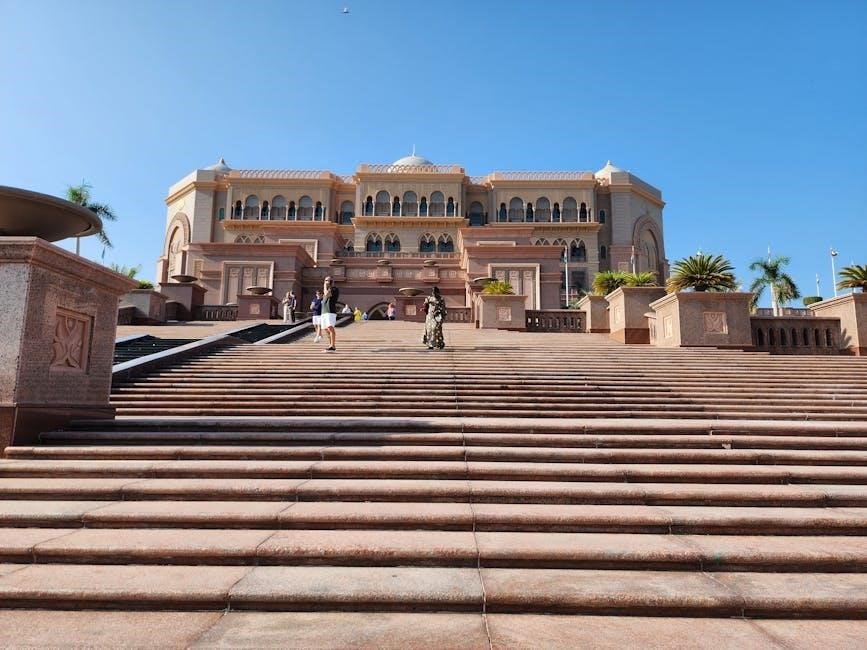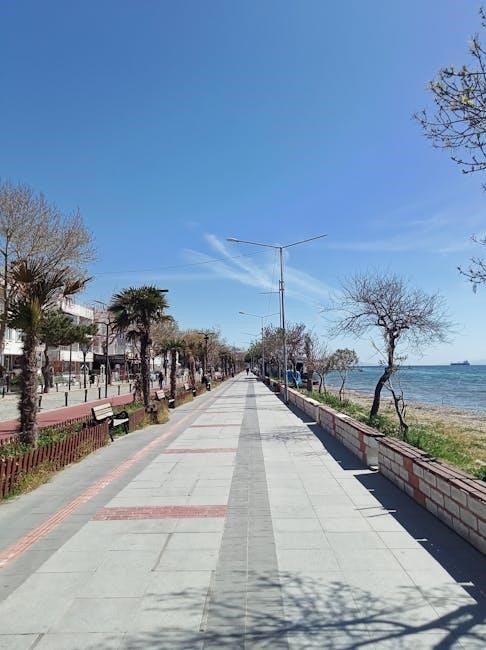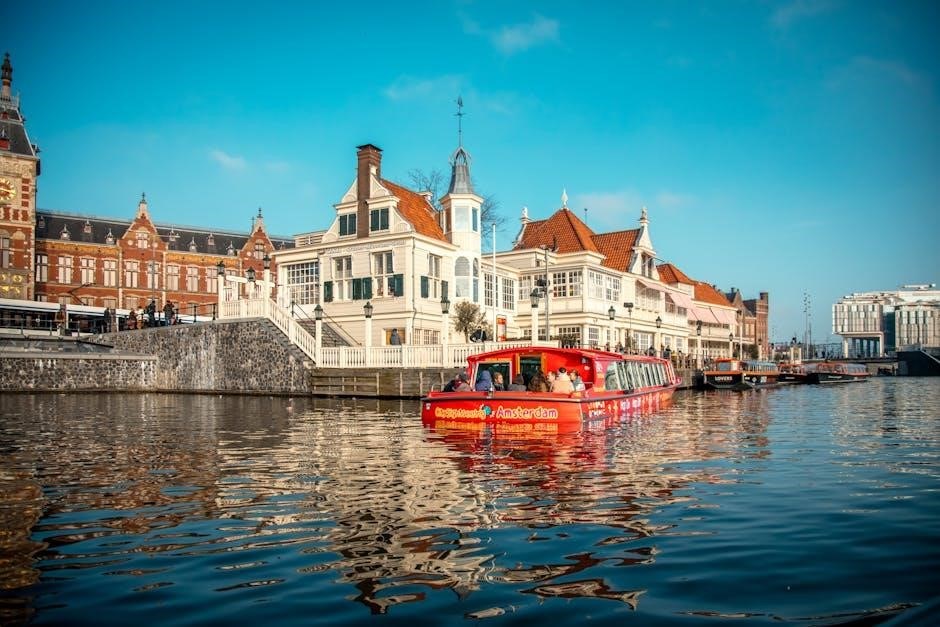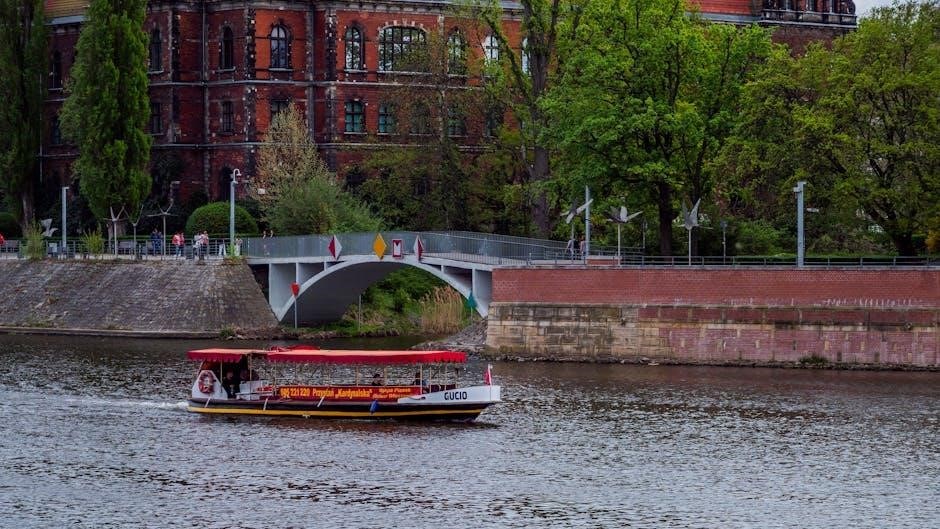Palm Springs offers a unique blend of architectural styles, making it a paradise for design enthusiasts. Self-guided tours allow visitors to explore iconic homes and landmarks at their own pace, experiencing the city’s rich architectural heritage firsthand. With its mid-century modern gems and desert modernist designs, Palm Springs provides an inspiring journey through timeless design and innovation.
Overview of Palm Springs as an Architectural Hub
Palm Springs is renowned as a vibrant architectural hub, blending mid-century modern design with desert modernism. The city’s sunny climate and stunning desert landscape inspired iconic architects like Albert Frey and Donald Wexler to create innovative, functional homes. Characterized by large windows, open spaces, and integration with nature, these designs reflect the area’s unique aesthetic. Neighborhoods like El Rancho Vista Estates and Old Las Palmas showcase historic homes, while landmarks such as the Kaufmann House highlight the city’s architectural legacy. Palm Springs’ architectural diversity attracts enthusiasts worldwide, offering a rich exploration of modernist design.
Why Choose a Self-Guided Tour?
A self-guided architecture tour in Palm Springs offers unparalleled flexibility and personalization. Visitors can explore at their own pace, focusing on specific styles or neighborhoods that interest them most. With tools like GPS-guided maps and downloadable apps, navigating the city’s iconic homes and landmarks becomes seamless. Self-guided tours allow for a deeper connection to the architecture, enabling visitors to linger at breathtaking sites or skip less intriguing ones. This approach also accommodates varying schedules and preferences, making it ideal for both casual enthusiasts and dedicated design buffs.
Popular Architectural Styles in Palm Springs
Palm Springs is renowned for its mid-century modern and desert modernist designs, which dominate the architectural landscape. These styles emphasize clean lines, open spaces, and harmony with the desert environment. Mid-century modern homes feature large windows, minimalist decor, and integration with outdoor living spaces. Desert modernism, a unique local style, often incorporates bold geometric forms and innovative use of materials to reflect the region’s arid beauty. These architectural styles have cemented Palm Springs’ reputation as a hub for modernist design and continue to inspire visitors and architects alike.

Mid-Century Modern Architecture in Palm Springs
Palm Springs is iconic for its mid-century modern architecture, characterized by clean lines, open spaces, and seamless integration with the desert landscape, attracting design enthusiasts worldwide.
Origins and Evolution of Mid-Century Modern Design
Mid-century modern design emerged in the 1930s, flourishing through the 1960s, influenced by the desert landscape and innovative architects like Albert Frey and Donald Wexler. The style emphasized simplicity, functionality, and harmony with nature, evolving to include large windows, open floor plans, and minimalist aesthetics. Palm Springs became a hub for this movement, blending modernism with desert living, creating iconic homes that reflect the era’s design philosophy and remain a cornerstone of the city’s architectural identity.
Famous Architects Associated with Mid-Century Modern in Palm Springs
Palm Springs’ mid-century modern architecture is legendary, thanks to visionary architects like Richard Neutra, Albert Frey, and Donald Wexler. Neutra’s Kaufmann House is a masterpiece, while Frey’s designs, such as the Aerial Tramway Station, exemplify desert modernism. Wexler pioneered prefabricated homes, blending affordability with modernist aesthetics. These architects’ contributions transformed Palm Springs into a mecca of modern design, leaving a lasting legacy that continues to inspire architectural enthusiasts on self-guided tours, showcasing their innovative and timeless creations.
Key Characteristics of Mid-Century Modern Homes
Mid-century modern homes in Palm Springs are defined by their minimalist design, emphasizing functionality and harmony with nature. Large glass windows and sliding doors create seamless indoor-outdoor living, while open floor plans foster a sense of space and flow. Flat or butterfly roofs, minimalist ornamentation, and an emphasis on horizontal lines are hallmark features. These homes often incorporate natural materials like wood and stone, blending modern aesthetics with the desert landscape. The integration of outdoor spaces, such as pools and gardens, further enhances the connection between architecture and environment, making these homes timeless and iconic.

Desert Modernism: A Unique Palm Springs Style
Desert Modernism emerged in the 1950s and 1960s, blending minimalist design with the desert landscape. It emphasizes indoor-outdoor living, natural materials, and innovative construction techniques, creating a distinct architectural identity.
Defining Features of Desert Modernism
Desert Modernism is characterized by open floor plans, large windows, and sliding glass doors that blur the line between indoors and outdoors. The use of natural materials like stone and wood, along with minimalist ornamentation, creates a harmonious relationship with the desert environment. Low-pitched gabled roofs and wide overhangs provide shade, while innovative construction techniques and an emphasis on functionality further define this unique architectural style, making it both aesthetically pleasing and environmentally adaptive.
Notable Examples of Desert Modernist Architecture
Desert Modernist architecture is exemplified by iconic structures like the Kaufmann House, designed by Richard Neutra, which seamlessly integrates indoor and outdoor spaces. Another standout is Donald Wexler’s Steel Development House #1, showcasing innovative use of materials. These buildings highlight the style’s emphasis on simplicity, functionality, and harmony with the desert landscape, making them must-see destinations for architectural enthusiasts exploring Palm Springs.
How Desert Modernism Differs from Mid-Century Modern
Desert Modernism diverges from Mid-Century Modern by emphasizing climate responsiveness and natural material integration. While Mid-Century Modern focuses on clean lines and organic shapes, Desert Modernism prioritizes blending structures into the desert landscape. It often incorporates earthy tones and adaptive design elements, such as overhangs and open courtyards, to harmonize with the arid environment. This unique adaptation makes Desert Modernism a distinct evolution of modernist principles, tailored to Palm Springs’ unique setting and environmental challenges.

Top Neighborhoods for Architectural Exploration
Explore iconic neighborhoods like El Rancho Vista Estates, Indian Canyons, Old Las Palmas, and Movie Colony, each showcasing unique architectural gems and historic significance in Palm Springs.
El Rancho Vista Estates: A Mid-Century Modern Enclave
El Rancho Vista Estates is a must-visit neighborhood for mid-century modern enthusiasts. Known for its iconic architecture, the area features sprawling homes with clean lines, large windows, and open floorplans. The community showcases seamless indoor-outdoor transitions, blending desert landscapes with modernist designs. As a residential enclave, visitors can admire the exterior beauty while respecting the privacy of its inhabitants. This neighborhood is a testament to Palm Springs’ architectural legacy, offering a glimpse into the mid-century modern lifestyle that defined the city’s design movement.
Indian Canyons: A Blend of Nature and Architecture
Indian Canyons, located just outside Palm Springs, harmoniously combines natural beauty with architectural intrigue. The area features ancient palm oases, stunning rock formations, and the historic oasis of Palm Canyon. Visitors can explore the Andreas Canyon and Murray Canyon trails, surrounded by breathtaking natural landscapes. The mix of pristine nature and subtle human-made structures creates a serene environment, offering a unique contrast to the modernist architecture found elsewhere in the city. This blend makes Indian Canyons a captivating stop for those exploring the intersection of nature and design in Palm Springs.
Old Las Palmas: Historic Homes and Celebrity Residences
Old Las Palmas is a historic neighborhood renowned for its iconic homes and celebrity ties. This enclave boasts stunning mid-century modern and Spanish Colonial Revival architecture, attracting architecture enthusiasts and history buffs. Once a retreat for Hollywood stars like Cary Grant and Katharine Hepburn, the area features beautifully preserved homes that reflect the glamour of Palm Springs’ golden era. A self-guided tour here offers a glimpse into the lives of legends, with properties that blend seamlessly into the desert landscape, showcasing timeless design and sophistication.
Movie Colony: Architectural Gems and Hollywood History
Movie Colony, a historic neighborhood in Palm Springs, is a treasure trove of architectural gems intertwined with Hollywood glamour. Known for its mid-century modern and Spanish Colonial Revival homes, this area was once a retreat for stars like Frank Sinatra and Bob Hope. The neighborhood’s design emphasizes indoor-outdoor living, with sprawling landscapes and pools blending seamlessly into the desert. A self-guided tour reveals the intricate details of these iconic properties, offering a glimpse into the lives of Hollywood legends and the architectural brilliance that defines this historic enclave.

Famous Architects and Their Contributions
Famous architects like Albert Frey and Richard Neutra left an indelible mark on Palm Springs, blending modernism with desert landscapes to create iconic, timeless designs that inspire visitors.
Albert Frey: The Father of Desert Modernism
Albert Frey, a Swiss-born architect, is celebrated as the father of Desert Modernism in Palm Springs. His work seamlessly integrates buildings with their surroundings, emphasizing harmony between architecture and nature. Frey’s designs, such as the iconic Aerial Tramway Valley Station, showcase his innovative use of simple forms and materials suited to the desert environment. His contributions have significantly shaped the architectural identity of Palm Springs, making his creations must-see stops on any self-guided tour.
Donald Wexler: Pioneering Prefabricated Homes
Donald Wexler, a renowned architect, revolutionized affordable modern design through his innovative use of prefabricated homes. His Steel Development House series, designed for efficiency and accessibility, showcased how modern architecture could be attainable for the masses. Wexler’s work in Palm Springs blended functionality with sleek, minimalist aesthetics, using materials like steel frames to create lightweight yet durable structures. His designs emphasized harmony with the desert landscape, making his homes timeless examples of mid-century modern innovation. Wexler’s contributions remain a cornerstone of Palm Springs’ architectural legacy, inspiring self-guided tours to explore his groundbreaking creations.
Richard Neutra: Master of Modernist Design
Richard Neutra, a visionary architect, left an indelible mark on Palm Springs with his modernist masterpieces. His designs emphasized harmony between architecture and nature, creating spaces that seamlessly integrate indoor and outdoor living. Neutra’s Kaufmann House, a iconic example of mid-century modern design, showcases his mastery of natural light, minimalist lines, and functional elegance. His work continues to inspire architectural enthusiasts, making his homes a must-see destination for self-guided tours in Palm Springs, offering a glimpse into the timeless beauty of modernist design.
William F. Cody: Architect of the Desert
William F. Cody, a renowned architect, brought a unique aesthetic to Palm Springs, blending desert modernism with organic design. His work often featured natural materials like stone and wood, harmonizing with the arid landscape. Cody’s designs, such as the Del Marcos Hotel and his own residence, highlight his ability to merge functionality with artistic expression. His contributions to Palm Springs’ architectural scene have left a lasting legacy, making his creations essential stops on any self-guided tour exploring the city’s rich design heritage.

Planning Your Self-Guided Tour
Plan your tour with detailed maps, GPS-enabled apps, and printed guides to navigate Palm Springs’ iconic architecture. Allocate 2-3 hours for a comprehensive exploration of key sites.
Best Maps and Guides for a Self-Guided Tour
Utilize detailed maps and guides to navigate Palm Springs’ architectural gems. GPS-enabled apps like the Palm Springs Modern Map offer real-time directions, while printed guides provide insights into historic homes and landmarks. The Desert Modernism Guide is a popular choice, highlighting iconic mid-century modern and desert modernist designs. Many resources include routes optimized for a 2-3 hour tour, ensuring you explore the city’s architectural highlights efficiently. Combine digital tools with physical maps for a seamless and enriching experience.
Essential Tools: GPS, Apps, and Printed Guides
GPS navigation and apps like Palm Springs Modern Map are indispensable for self-guided tours, offering real-time directions and location-based insights. Printed guides provide detailed descriptions and historical context, complementing digital tools. Combining these resources ensures a comprehensive exploration of architectural landmarks. Apps often feature curated routes, while maps highlight hidden gems. These tools enhance the tour experience, allowing visitors to discover iconic designs effortlessly. They are particularly useful for navigating neighborhoods like El Rancho Vista Estates and Indian Canyons, ensuring a seamless and informative journey through Palm Springs’ architectural landscape.
Recommended Transportation for the Tour
Renting a car is highly recommended for a self-guided architecture tour in Palm Springs, as it offers flexibility and ease in exploring the city’s sprawling neighborhoods. Public transportation is limited, making a vehicle essential for accessing remote areas. Walking or cycling is feasible for shorter distances but may not be practical for a comprehensive tour. Ride-sharing services are available but can be costly for extended use. A car allows visitors to navigate at their own pace, ensuring they can fully appreciate the architectural gems in areas like El Rancho Vista Estates and Old Las Palmas.
Timing and Duration: How Long to Allocate
A self-guided architecture tour in Palm Springs can be tailored to fit your schedule, but allocating at least 2-3 hours is recommended to explore key neighborhoods and landmarks. Start early to avoid midday heat and traffic, allowing time to linger at standout properties. For a more immersive experience, consider dedicating a full day, especially if you plan to combine architecture with art or outdoor activities. Flexibility is key, as you can pause or extend your tour based on personal interest and discovery.

Key Buildings and Landmarks to Visit
Explore iconic landmarks like the Kaufmann House, House of Tomorrow, and Palm Springs Art Museum. St. Theresa Catholic Church also stands out as a unique architectural gem in the city.
Kaufmann House: A Masterpiece of Mid-Century Modern
The Kaufmann House, designed by Richard Neutra in 1947, is a landmark of mid-century modern architecture in Palm Springs. Known for its sleek lines, open spaces, and seamless integration with the desert landscape, the house exemplifies the principles of modernist design. Its innovative use of glass, steel, and natural materials creates a harmonious blend of indoor and outdoor living. As a winter retreat for the Kaufmann family, it reflects the era’s emphasis on functionality and aesthetic simplicity. Today, it remains a must-visit for architecture enthusiasts exploring Palm Springs’ iconic homes.
The House of Tomorrow: A Visionary Design
Designed by Albert Frey in 1960 for the Kaufmann family, the House of Tomorrow is a futuristic icon in Palm Springs. Its circular living area, retractable walls, and innovative use of natural materials like stone and steel redefine modern living. The house seamlessly integrates into the desert landscape, emphasizing harmony between architecture and nature. As a National Historic Landmark, it showcases forward-thinking design and remains a cornerstone of Palm Springs’ architectural legacy, inspiring visitors on self-guided tours to envision the future of home design.
The Palm Springs Art Museum: A Modern Icon
The Palm Springs Art Museum is a striking example of modern architecture, located in the heart of downtown. Designed by E. Stewart Williams in 1976, the museum features a minimalist design with clean lines and a focus on natural light. Its bold, contemporary aesthetic complements the desert backdrop, making it a must-visit for architecture enthusiasts. The museum not only showcases an impressive collection of contemporary art but also hosts rotating exhibitions that highlight local and international talent. With its sleek, functional design, the Palm Springs Art Museum stands as a cultural and architectural beacon in the city.
St. Theresa Catholic Church: A Unique Architectural Statement
Designed by renowned architect William F. Cody, the St. Theresa Catholic Church stands out as a harmonious blend of modernist design and traditional ecclesiastical elements. Its striking façade, minimalist decor, and abundant natural light create a serene atmosphere, reflecting the desert landscape. The church’s architecture, while deeply rooted in its religious purpose, offers a contemporary aesthetic that resonates with the city’s mid-century modern influence; This iconic landmark is not only a spiritual hub but also a testament to Palm Springs’ architectural diversity and innovative design.

Combining Architecture with Other Attractions
Blend architectural exploration with Palm Springs’ vibrant cultural scene, local gardens, and culinary hotspots for a richer, more immersive experience during your self-guided tour.
Exploring Palm Springs’ Art Scene
Palm Springs’ vibrant art scene complements its architectural heritage, offering a rich cultural experience. The Palm Springs Art Museum showcases contemporary and modern art, while local galleries feature works by regional artists. Public installations like the “Forever Marilyn” sculpture add to the city’s artistic charm. Combining art exploration with architecture tours provides a deeper understanding of Palm Springs’ creative identity, making it a must-visit destination for art and design enthusiasts alike.
Visit Local Gardens and Outdoor Spaces
Palm Springs’ stunning gardens and outdoor spaces offer a perfect blend of natural beauty and architectural inspiration. The Indian Canyons, featuring ancient oases, provide a serene escape, while the Moorten Botanical Garden showcases desert flora. Sunnylands, with its meticulously designed gardens, reflects the city’s mid-century modern aesthetic. These outdoor spaces not only complement the architectural tours but also highlight the region’s unique desert landscape, offering a refreshing contrast to the built environment.
Enjoy Dining at Architecturally Significant Restaurants
Combine your architectural tour with a culinary experience at Palm Springs’ iconic restaurants. Places like Norma’s at the Parker Palm Springs and Workshop Kitchen + Bar showcase mid-century modern and industrial-chic designs. These eateries blend seamlessly into the city’s architectural fabric, offering a chance to dine in spaces that reflect the same design principles as the homes and landmarks you’re exploring. Savor local cuisine while surrounded by the city’s signature style, making your tour a delightful fusion of food, design, and culture.

Preservation and Cultural Impact
Palm Springs’ architectural legacy is preserved through dedicated efforts, ensuring its mid-century modern and desert modernist designs endure; These structures shape the city’s cultural identity and inspire future generations.
Historic Preservation Efforts in Palm Springs
Palm Springs has robust preservation initiatives, including the city’s Historic Site Preservation Board, which designates and protects landmarks. Nonprofits like the Palm Springs Preservation Foundation and the Modernism Committee actively advocate for the conservation of significant buildings. Self-guided tours highlight these efforts, showcasing restored mid-century modern homes and iconic structures that contribute to the city’s cultural heritage. These efforts ensure that Palm Springs’ architectural legacy remains accessible and appreciated by future generations, maintaining its status as a design destination.
The Role of Architecture in Shaping Local Culture
Palm Springs’ architecture plays a pivotal role in shaping its cultural identity. The city’s iconic mid-century modern and desert modernist designs have become synonymous with its reputation as a design destination. These styles reflect the community’s appreciation for innovation and aesthetics, attracting architecture enthusiasts and influencing local art, events, and lifestyle. The fusion of modernist principles with desert landscapes has created a unique cultural vibe, fostering creativity and pride among residents. This architectural legacy continues to inspire and define Palm Springs as a hub of modern design and cultural expression.
Community Initiatives to Promote Architectural Heritage
Palm Springs’ community actively preserves its architectural legacy through various initiatives. Local organizations, such as the Palm Springs Mod Squad, organize tours and events to educate visitors about the city’s design history. Collaborations with architects, historians, and residents ensure the heritage is celebrated and protected. These efforts not only highlight iconic buildings but also foster a sense of pride and cultural identity within the community. By engaging the public, Palm Springs continues to honor its architectural roots while inspiring future generations to appreciate its unique design heritage.
Self-guided architecture tours in Palm Springs offer a flexible and enriching way to explore its iconic designs. This approach allows visitors to immerse themselves in the city’s architectural legacy at their own pace, creating unforgettable experiences and fostering a deeper appreciation for its unique cultural and design heritage.
Final Tips for a Memorable Self-Guided Tour
- Download detailed maps and guides beforehand to ensure smooth navigation.
- Allocate ample time to explore each property without rushing.
- Use a reliable GPS or app for precise directions and insights.
- Respect private properties and adhere to local regulations.
- Capture memories with photography, but avoid trespassing.
- Stay hydrated and plan breaks in shaded areas during hot days.
- Combine architecture with local art and dining for a holistic experience.
Encouraging Future Exploration and Appreciation
Exploring Palm Springs’ architectural gems fosters a deeper appreciation for design and history, inspiring future discoveries. By engaging with the city’s unique structures, visitors gain a sense of accomplishment and connection to its cultural legacy. Share experiences with others to spark curiosity and encourage continued exploration. Community initiatives and events further promote architectural heritage, making it easier for enthusiasts to delve deeper. Embrace the joy of uncovering hidden gems and the satisfaction of learning about timeless design principles that define Palm Springs’ identity.

Additional Resources
- Recommended books on Palm Springs architecture offer in-depth insights.
- Online communities and forums connect enthusiasts globally.
- Local workshops and events provide hands-on learning opportunities.
Recommended Books on Palm Springs Architecture
Several books provide deep insights into Palm Springs’ architectural landscape. Mid-Century Modern Architecture in Palm Springs by Daniel Chavkin highlights iconic designs. Palm Springs Modern by Michael Stern explores the city’s architectural evolution. Desert Modernism by Alan Hess delves into the unique style of desert modernist homes. These books are essential for understanding the city’s design heritage and planning a self-guided tour. They offer detailed histories, architect profiles, and stunning visuals, making them invaluable resources for architecture enthusiasts and visitors alike.
Online Communities and Forums for Architecture Enthusiasts
Online forums and communities are invaluable for architecture enthusiasts planning self-guided tours in Palm Springs. Groups on Facebook, Reddit, and specialized architecture forums often share insights, photos, and recommendations. platforms like Google Maps and GPS-guided tour apps provide interactive routes. Social media groups dedicated to mid-century modern design and desert modernism offer insider tips. These digital spaces foster connections among enthusiasts, helping visitors discover hidden gems and stay updated on architectural events in Palm Springs.
Local Workshops and Events for Architectural Learning
Palm Springs hosts various workshops and events that cater to architecture enthusiasts. Events like Modernism Week offer lectures, tours, and hands-on activities, providing deep insights into the city’s design heritage. Local schools and cultural organizations often organize workshops on topics like mid-century modern restoration and sustainable desert design. These events are perfect for learners seeking to enhance their knowledge and connect with like-minded individuals. Additionally, expert-led sessions and panel discussions offer unique perspectives on the evolution of Palm Springs’ architectural landscape.


